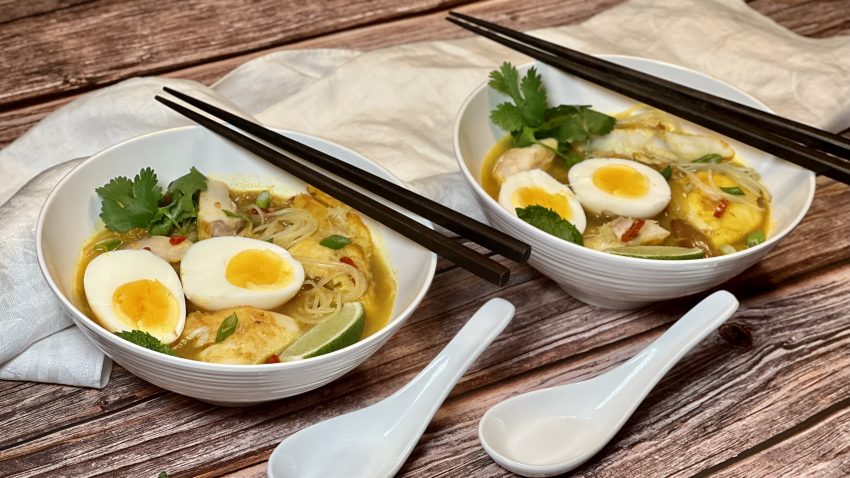Mohinga, Burmese National Dish based on the recipe by Daw Hla of 132 Edward Street in Rangoon. According to the 1956 edition of Rangoon International Cook Book, Daw Hla was “reputed as the best Mohinga cook in the city, catering for more than 40 years… for the Union Club and Orient Club.”
In MO-HINGA, MO is cold rice noodles and HINGA is the hot aromatic gravy. They are usually served separately and combined together in individual bowls at the table.
It took me about two hours to decipher the 25 lines devoted to this recipe in the book, converting viss and ticals into pounds and ounces, researching nga gyi and nga pi gaung. Banana trunk turned out to be unprocurable in New Jersey and duck eggs had to be replaced by those of a chicken.
Besides some frivolities in garnishes — cilantro, scallions, and balanchaung were not mentioned in the book – I tried to stay true to the advice of Daw Hla.
THE BROTH
— 2 lb basa
— 1 lb salted mackerel
— 2 blades of lemon grass, tough outer leaves removed, smashed with the cleaver
— 3 Tbsp fish sauce
— 3 chile peppers
— 1 tsp turmeric
— water to cover the fish
THE GRAVY
— 7 garlic cloves, roughly chopped
— 2“ piece of ginger, roughly chopped
— 3 lemongrass stalks, tough outer leave removed, soft inner parts roughly chopped
— 3 chile peppers
— 2 Tbsp rice flour
— 2 Tbsp chickpea flour
— 5-7 Tbsp of peanut oil
— 5 onions, sliced
— 1 Tbsp turmeric powder
— 1 tsp chili powder
— 1 tsp paprika
— 1 can coconut milk
— 3 cups water
— 3 Tbsp fish sauce
— 1/2 lb small shallots, peeled and quartered
TO SERVE
— rice vermicelli
— boiled eggs
— cilantro
— scallions
— chili flakes
— crispy shallots or balanchaung
— sliced limes
THE PROCESS
1. In a soup pot, combine all ingredients for the broth, bring to a simmer and cook until the fish is ready, about 30 minute altogether.
2. Remove the fish to a plate, discard the skin, debone, break into serving size pieces, and cover.
3. Strain the broth through a sieve or a cheesecloth. Set aside.
4. Cook rice vermicelli according to the package instructions and keep in cold water.
5. Boil the eggs to the consistency you like. Cool, peel, and set aside.
6. In a food processor, or in a mortar with a pestle, or with an immersion blender make a rough paste with garlic, ginger, lemongrass, and chilies. Rub about a third of this aromatic paste into the cooked fish and set the rest aside.
7. Toast both flours together on a dry griddle until they turn light brown and you can smell their nutty aroma. Set aside.
8. Prep the rest of the garnishes.
9. In a large clean soup pot, cook onions in oil until they are soft, deep brown, and begin to caramelize.
10. Add the rest of the aromatic paste into the onions, and cook scraping the brown bits off the pan for about a minute or so, until you begin to smell the paste.
11. Add turmeric, chili powder, paprika and toasted flours to the onions and mix in well.
12. Add strained fish broth, coconut milk, water, and fish sauce to the pot and making sure there are no flour clumps. Bring to a simmer.
13. Add quartered shallots and turn the heat off when they become tender.
14. On the bottom of each serving bowl, place cooked strained cold rice vermicelli, fish, and add the gravy.
15. Garnish with eggs and the rest as you like.


